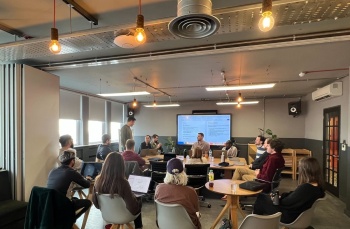
The ‘magic formula’ for setting digital teams up for success
Here our Delivery Lead, Leslie Burrows, emphasises that successfully implementing these elements can lead to higher productivity, creativity, and job satisfaction, reducing staff turnover and enhancing overall performance.

- Team Success
- Digital Teams
- Digital Agency
Article originally published in WeAreTechWomen: wearetechwomen.com/
Every digital agency has a different way of operating: some choose to split the time of team members across multiple accounts, whilst others create dedicated multidisciplinary 'squads' that are solely focused on one client.
The benefits of operating a squad model are clear: greater autonomy, knowledge sharing, ownership, and stronger teams. But teams are not always set up for success when it comes to ways of working, team integration and trust, which stands in the way of efficiency, creativity and enjoyment.
The squad should be empowered to be creative and enjoy their work while having the culture and processes in place needed to solve problems effectively and reduce ‘dead time’ spent on time-consuming admin. Only then can they gain headspace and focus on the best parts of their jobs.
So, what do we need to consider to ensure that teams are in the best position possible to succeed? Here are the six things to focus on to improve efficiency, enhance creativity and make the process of scrum working enjoyable:
1. Consistency
By adhering to a baseline, consistent process agency-wide, we establish greater clarity and ensure team members can seamlessly transition between projects and teams. This means newcomers can hit the ground running with minimal adjustment time, focusing their energy on understanding client needs and delivering the highest quality work.
The more consistent you can be across responsibilities and activities, the more the team and your wider stakeholders will benefit:
- Ceremonies – daily standups, retrospectives, and team catch-ups – are the backbone of successful collaboration, ensuring that everyone is on the same page, fostering better communication and creating alignment towards project goals
- From project management to design and collaboration, maintaining consistency in tool usage helps to build greater efficiency and collaboration. When the same tools are always used, it reduces the learning curve and maximises productivity
- Consistent documentation processes ensure that vital information is readily accessible to everyone, facilitating smoother workflows
- Reporting practices ensure that wider stakeholders have access to accurate and timely information without requiring any additional admin work from the team
2. Integration
Finding areas where tools can be integrated or streamlined reduces the need to copy actions or projects from one tool to another, giving teams more headspace for creative thinking and meaningful work. Integrating multiple tools eliminates the need for extensive training on different platforms, with employees simply mastering one integrated environment.
Whether it’s integrating commercial time tracking or HR tools into existing project management tools, bringing as many tools and processes together as possible helps to reduce and streamline the administrative burden, and enhances visibility across teams so that everyone is fully informed, allowing for better planning.
3. Automation
Using automation can help to reduce pointless admin and reduce stress, especially when teams can draw on new AI technology. Identifying areas for automation can create more time for teams to focus their energy on the work itself, reducing burnout and fostering a more positive work environment, which has been shown to enhance productivity.
As teams work together more, processes can be honed further – as long as there are avenues for retrospective and collaborative thinking – further enhancing efficiency and reducing frustration with long-winded or repetitive tasks.

4. Flexibility and autonomy
While having processes and systems in place is critical for teams to run smoothly, every team is different, and flexibility allows them to adjust their ways of working so that they can work together more effectively. It significantly enhances collaboration, retention and overall results, but it is critical to find the right balance.
Some processes you might typically use may just not work well for a certain project, and teams need the freedom to implement changes that will make their lives easier, and their working life more enjoyable. This might include moving standups to later in the day, adding additional layers of automation or setting time aside for idea sharing.
While empowering teams to make decisions autonomously is important, it is also crucial to enable guided development, where more experienced team members step in to ensure that changes are implemented thoughtfully and in line with broader organisational objectives, maintaining cohesion with the wider team.
5. Ownership and accountability
Moving to a flatter organisational structure empowers every team member to take accountability for specific areas, reducing the risk of confusion and inefficiency. This approach encourages individual growth and fosters a sense of community and accountability across the team, helping those involved to be more engaged with the project.
6. Active management
Creating an environment of active management within a team is essential for fostering honesty, feedback and unity, especially when working with remote teams. Establishing the right culture is critical for enabling teams to work together effectively as well as improving the experience of individual team members.
It is important that team members feel they can be honest about things that are not working for them, and to do that managers need to establish a safe environment for feedback. This can be done by:
- Establishing an open culture – Creating a safe space where individuals feel comfortable sharing their concerns engenders open communication and honesty, helping teams to address issues promptly and effectively.
- Embracing and acting on feedback – Constructive feedback, when given and received positively, fosters a culture of continuous improvement and mutual respect. Not all issues have quick solutions, but testing different options with the team over a defined period can help defuse disagreements.
- Creating regular opportunities – Retrospectives provide a structured forum for teams to reflect on their successes and areas for improvement together, creating a sense of unity.
- Encourage in-person connections – While remote work is common, in-person meetings can help to strengthen relationships and develop deeper connections. Even if meeting up in person isn’t possible, making time for non-work-related conversations can help to build camaraderie.
- Embrace changes – Nothing changes if nothing changes, so encouraging a culture of adaptation ensures that teams thrive over time.
When you can get the ‘magic formula’ right, the result is a happier, more productive and more efficient team, with lower turnover. The more you can establish an environment where teams can enjoy their work, the better the outcomes will be.
Want more on team success?


How video can support digital transformation and internal buy-in
- Healthcare
- Pharmaceutical
- Strategy
How can pharma teams optimise their HCP portals to strengthen HCP relationships and impact patient outcomes?
- Healthcare
- Pharmaceutical
- Customer Experience